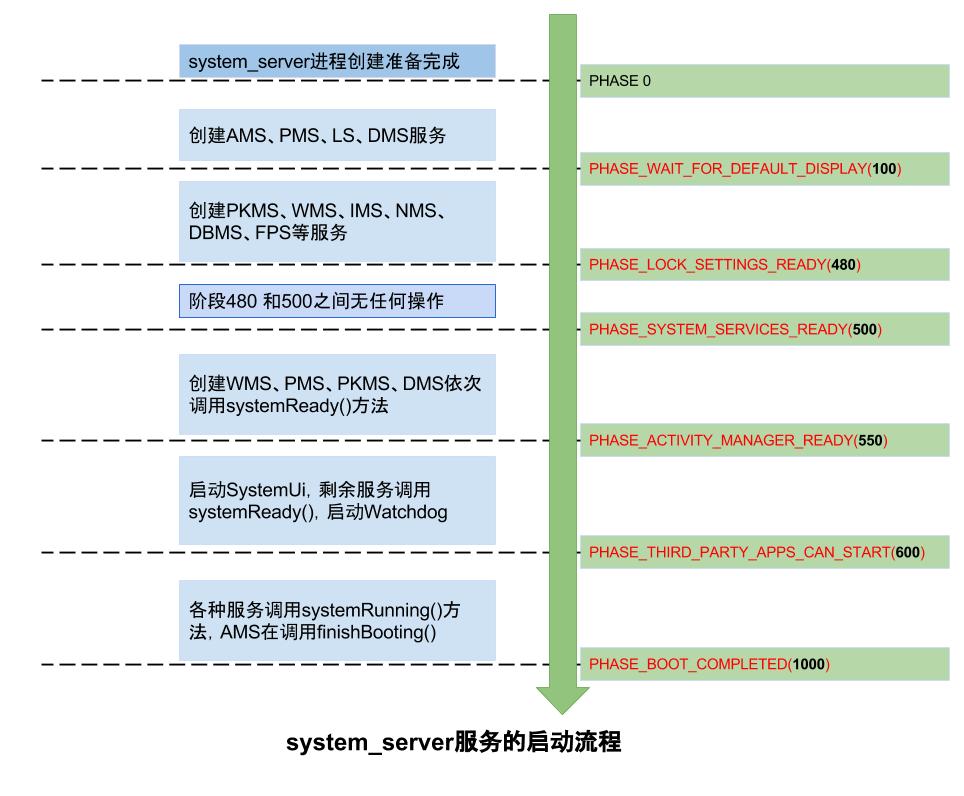一. 概述
启动启动过程有采用过两种不同的方式来注册系统服务:
- ServiceManager的addService()
- SystemServiceManager的startService()
其核心都是向ServiceManager进程注册binder服务,但功能略有不同,下面从源码角度详加说明。
二. SM.addService方式
这里以InputManagerService服务为例, 说明这类服务的启动方式:
inputManager = new InputManagerService(context, null); //先创建服务对象
ServiceManager.addService(Context.INPUT_SERVICE, inputManager); //[见小节2.1]
2.1 SM.addService
[-> ServiceManager.java]
public static void addService(String name, IBinder service) {
try {
// [见小节2.2 和 2.3]
getIServiceManager().addService(name, service, false);
} catch (RemoteException e) {
Log.e(TAG, "error in addService", e);
}
}
2.2 SM.getIServiceManager
[-> ServiceManager.java]
private static IServiceManager getIServiceManager() {
if (sServiceManager != null) {
return sServiceManager;
}
//【见2.2.1】
sServiceManager = ServiceManagerNative.asInterface(BinderInternal.getContextObject());
return sServiceManager;
}
采用了单例模式获取ServiceManager getIServiceManager()返回的是ServiceManagerProxy(简称SMP)对象.
其中BinderInternal.getContextObject(), 等价于new BpBinder(0), handle=0意味着指向的是远程进程/system/bin/servicemanager中的 ServiceManager服务.
2.2.1 asInterface
[-> ServiceManagerNative.java]
public abstract class ServiceManagerNative extends Binder implements IServiceManager
{
static public IServiceManager asInterface(IBinder obj)
{
if (obj == null) {
return null;
}
IServiceManager in =
(IServiceManager)obj.queryLocalInterface(descriptor);
if (in != null) {
return in;
}
//创建ServiceManagerProxy对象[见小节2.2.2]
return new ServiceManagerProxy(obj);
}
}
2.2.2 ServiceManagerProxy创建
[-> ServiceManagerNative.java ::ServiceManagerProxy]
class ServiceManagerProxy implements IServiceManager {
private IBinder mRemote;
public ServiceManagerProxy(IBinder remote) {
mRemote = remote;
}
...
}
可见, getIServiceManager()过程是获取一个用于跟远程ServiceManager服务(这个用于管理所有binder服务的大管家)进行通信的binder代理端.
2.3 SMP.addService
[-> ServiceManagerNative.java ::ServiceManagerProxy]
public void addService(String name, IBinder service, boolean allowIsolated)
throws RemoteException {
Parcel data = Parcel.obtain();
Parcel reply = Parcel.obtain();
data.writeInterfaceToken(IServiceManager.descriptor);
data.writeString(name);
data.writeStrongBinder(service);
data.writeInt(allowIsolated ? 1 : 0);
mRemote.transact(ADD_SERVICE_TRANSACTION, data, reply, 0);
reply.recycle();
data.recycle();
}
通过mRemote向将ADD_SERVICE_TRANSACTION的事件发送给ServiceManager. 接下来的内容见Binder系列5—注册服务(addService).
三. SSM.startService方式
通过这种方式启动的服务,有一个特点都是继承于SystemService对象, 这里以PowerManagerService为例来说明:
//[见小节3.1]
mSystemServiceManager = new SystemServiceManager(mSystemContext);
//[见小节3.2]
mPowerManagerService = mSystemServiceManager.startService(PowerManagerService.class);
3.1 SSM初始化
[-> SystemServiceManager.java]
public class SystemServiceManager {
private final Context mContext;
//接收lifecycle事件的服务
private final ArrayList<SystemService> mServices = new ArrayList<SystemService>();
public SystemServiceManager(Context context) {
mContext = context;
}
}
mSystemServiceManager只会创建一次,后续其他服务通过该方式启动,直接调用其startService()方法即可。
3.2 SSM.startService
[-> SystemServiceManager.java]
public <T extends SystemService> T startService(Class<T> serviceClass) {
final String name = serviceClass.getName();
//保证要启动的服务是继承于SystemService,否则抛出异常
if (!SystemService.class.isAssignableFrom(serviceClass)) {
throw new RuntimeException(...);
}
final T service;
try {
Constructor<T> constructor = serviceClass.getConstructor(Context.class);
//通过反射创建目标服务类的对象
service = constructor.newInstance(mContext);
} catch (Exception ex) {
...
}
//将该服务添加到mServices
mServices.add(service);
try {
//执行服务的onStart过程
service.onStart();
} catch (RuntimeException ex) {
...
}
return service;
}
mSystemServiceManager.startService(xxx.class) 功能主要:
- 创建xxx类的对象,执行该对象的构造函数;
- 将该对象添加到mSystemServiceManager的成员变量mServices;
- 调用该对象的onStart();
看到这并没有看到服务是如何注册到ServiceManager, 这里继续以PowerManagerService为例,其实是在onStart()完成.
3.2.1 onStart
[-> PowerManagerService.java]
public void onStart() {
//[见小节3.2.2]
publishBinderService(Context.POWER_SERVICE, new BinderService());
publishLocalService(PowerManagerInternal.class, new LocalService());
Watchdog.getInstance().addMonitor(this);
Watchdog.getInstance().addThread(mHandler);
}
PowerManagerService定义了一个内部类BinderService, 继承于IPowerManager.Stub服务. 再调用publishBinderService来注册服务.
3.2.2 publishBinderService
[-> SystemService.java]
public abstract class SystemService {
protected final void publishBinderService(String name, IBinder service) {
publishBinderService(name, service, false);
}
protected final void publishBinderService(String name, IBinder service,
boolean allowIsolated) {
ServiceManager.addService(name, service, allowIsolated);
}
}
到此可见, 采用该方式真正注册服务的过程,同样也是采用ServiceManager.addService方式.
通过这种方式启动的服务, 都是继承于SystemService类, 那么这种方式启动的服务有什么特殊之处吗? 答应就是startBootPhase的过程:
3.3 SSM.startBootPhase
[–>SystemServiceManager.java]
public void startBootPhase(final int phase) {
mCurrentPhase = phase;
final int serviceLen = mServices.size();
for (int i = 0; i < serviceLen; i++) {
final SystemService service = mServices.get(i);
try {
service.onBootPhase(mCurrentPhase);
} catch (Exception ex) {
...
}
}
所有通过该方式注册的继承于SystemService的服务,都会被添加到mServices. 该方法会根据当前系统启动到不同的阶段, 则回调所有服务onBootPhase()方法
3.3.1 BootPhase
系统开机启动过程, 当执行到system_server进程时, 将启动过程划分了几个阶段, 定义在SystemService.java文件
public static final int PHASE_WAIT_FOR_DEFAULT_DISPLAY = 100;
public static final int PHASE_LOCK_SETTINGS_READY = 480;
public static final int PHASE_SYSTEM_SERVICES_READY = 500;
public static final int PHASE_ACTIVITY_MANAGER_READY = 550;
public static final int PHASE_THIRD_PARTY_APPS_CAN_START = 600;
public static final int PHASE_BOOT_COMPLETED = 1000;
这些阶段跟系统服务大致的顺序图,如下:

PHASE_BOOT_COMPLETED=1000,该阶段是发生在Boot完成和home应用启动完毕, 对于系统服务更倾向于监听该阶段,而非监听广播ACTION_BOOT_COMPLETED
四. 总结
方式1. ServiceManager.addService():
- 功能:向ServiceManager注册该服务.
- 特点:服务往往直接或间接继承于Binder服务;
- 举例:input, window, package;
方式2. SystemServiceManager.startService:
- 功能:
- 创建服务对象;
- 执行该服务的onStart()方法;该方法会执行上面的SM.addService();
- 根据启动到不同的阶段会回调onBootPhase()方法;
- 另外,还有多用户模式下用户状态的改变也会有回调方法;例如onStartUser();
- 特点:服务往往自身或内部类继承于SystemService;
- 举例:power, activity;
两种方式真正注册服务的过程都会调用到ServiceManager.addService()方法. 对于方式2多了一个服务对象创建以及 根据不同启动阶段采用不同的动作的过程。可以理解为方式2比方式1的功能更丰富。
微信公众号 Gityuan | 微博 weibo.com/gityuan | 博客 留言区交流